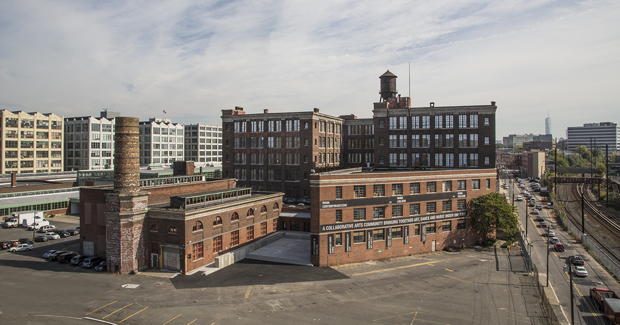
It’s tempting to describe Mana Contemporary as groundbreaking. Why? Still under development, the public art complex occupies more than 2 million square feet of Jersey City near Journal Square. Its main building, a six-story former tobacco factory, houses millions of dollars worth of precious art as well as a foundry, a high-end silk-screen operation, a museum of Richard Meier’s architectural models and the complete archives of the International Center of Photography (150,000 images formerly kept at the ICP in Manhattan). Ultimately, the complex will include five restaurants, a boutique hotel with a rooftop pool, a Meier-designed sculpture garden, a theater, 250 artist studios and a recording studio.
Mana Contemporary is the vision of Moishe Mana, an Israeli-born New York businessman whose empire started with a moving company in the 1980s and expanded to real estate development as well as wine, document and fashion storage. He opened a similar art complex in Chicago in 2013; that location is dwarfed by Mana Jersey City (aka Mana JC), which opened in 2011.
Size and scope, though, are not what Mana cofounder and president Eugene Lemay considers most impressive. Those who come for a tour—Mana JC is open weekdays from 10 am to 5 pm, and there is no admission fee—are likely to be captivated by its concept, which essentially is how elastic, breezy and interactive the experience of looking at art can be.
“At museums and galleries, you’re going to see the final product,” says Lemay, 54, of Hillsdale. “At Mana, you see the work in progress. So you can actually walk into the artist’s studio….You see the painting being painted, or the sculpture being sculpted. You can talk to the artist about his or her process.”
In the case of a current attraction, “Making Art Dance: Backdrops and Costumes Celebrating 30 Years of the Armitage Foundation,” you also can see a traditionally curated exhibition. “Making Art Dance,” which runs through March 13, culls set designs and costumes created by famed choreographer Karole Armitage with artists and fashion designers, including Jean Paul Gaultier, Jeff Koons and Christian Lacroix—all displayed in Mana’s 50,000-square-foot Glass Gallery. Adding to the experience, Armitage’s New York dance company, Armitage Gone! Dance, has a permanent residency at Mana. Her fourth-floor studio is walled with glass, allowing visitors to watch rehearsals.
Lemay says scheduling is not particularly important when planning a trip to Mana JC. “Ninety percent of the time, dancers will be dancing,” he says. And at least some artists making visual art, selected by Lemay and a committee of five, are always on hand, working in spacious, light-filled studios. They include fashion photographer Sante D’Orazio (Vogue, Vanity Fair) and sculptor Shelter Serra.
Bold-face names such as Marina Abramovic, the famed installation artist, and Gary Lichtenstein, the master printer, may be harder to pin down in Jersey City. But they are also aligned with Mana JC through ongoing collaborations, all masterminded and executed by Lemay, who calls himself “very persuasive.”
Many Mana artists are displaced New Yorkers. “Rents go up in places like SoHo, Williamsburg, Chelsea, and they get pushed out,” Lemay says. It has not been hard to lure them to Jersey City, where cultural and culinary attractions abound. Due to open in April in downtown Jersey City is White Eagle Hall, a venue for concerts and other performances with space for 400 seated and 800 standing. Todd Abramson, a former owner of Maxwell’s, the Hoboken music club that closed in 2013, is the music booker.
Culturally, “I think we’ve reached critical mass,” says Jersey City planning director Bob Cotter. “Nobody in the art world needs much convincing that it’s a good time to be in Jersey City.”



